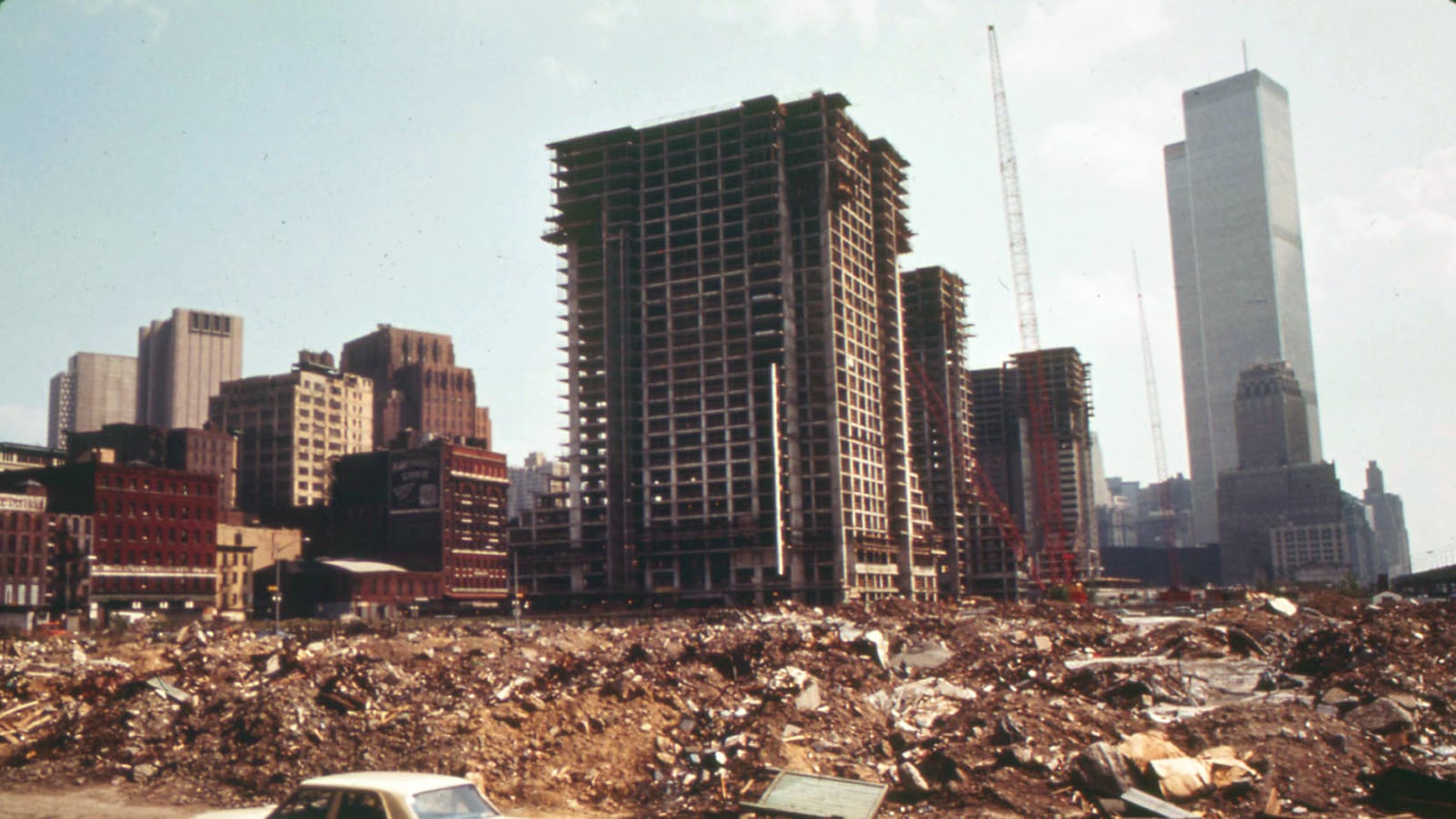This is part of our weekly series, Lost Masterpieces, about the greatest works of architecture and art that were destroyed or never completed.
Traipsing along the Hudson River on Manhattan’s West Side today, enjoying green spaces, stunning vistas, and happy people, it’s easy to forget that this area recently was a dump—symbolizing urban decay and governmental dysfunction.
After ships became too big to dock there, the rotting piers became wild urban hubs in the 1970s. A city of grime and crime supplanted the thrifty, hardworking, earnest metropolis of the 1940s and 1950s.
Today, as children laugh, birds tweet, waves lap amid cars whizzing by, belching exhaust, hear the ghost of the great Democratic Senator Daniel Patrick Moynihan whisper: “This is grand, but had you listened to me and built Westway, it would be heavenly!”
Westway! Neither violent video game nor cutesy startup, from 1974 to 1985 this multi-billion-dollar parkway project pitted 1930s Franklin-Roosevelt-the-bigger-the-better, red, white, and blue Public Works liberals against 1960s Jane Jacobs small-is-beautiful, Hippie-dippie green environmentalists.
America’s traditional republic run by elected officials representing the people clashed with a modern weathervane democracy sensitive to grassroots voices empowered by the media, regulations, and courts.
New York’s power elite—Nelson Rockefeller, Ed Koch, Mario Cuomo, and Daniel Patrick Moynihan—faced anonymous citizens, environmentalists, and judges, with a Donald Trump cameo. To Moynihan’s frustration and the activists’ delight, the Hudson River’s schools of striped bass defeated Midtown’s pinstriped powerbrokers.
In 1956, as New York deindustrialized, de-harbored, and declined, President Dwight Eisenhower launched the Interstate Highway System, the world’s greatest public works project.

The Federal-Aid Highway Act authorized $25 billion to unite America through a network of 41,000 miles of superhighway, making the Republican Ike an unwitting force in homogenizing and centralizing America.
The federal government provided 90 percent of the funds, giving Washington unprecedented blackmail leverage over local decisions and unexpected involvements in local messes.
More than his conservative adversaries, Daniel Patrick Moynihan appreciated all the good government could do; but more than most liberal friends, he also feared the harm it could cause. Before becoming the four-term New York Senator from 1977 to 2001, whose retirement paved the way for Hillary Clinton’s Senate career, Moynihan served in domestic and foreign capacities in the Kennedy, Johnson, Nixon, and Ford administrations.
In 1975, he thrilled a demoralized post-Watergate, post-Vietnam War nation by defying Soviet and Palestinian propagandists who tried bullying America by bullying its close ally Israel in the UN with the detestable Zionism-is-racism resolution.

Born in 1927, raised in New York’s tough Hell’s Kitchen, Moynihan became a Harvard professor with a charmingly unacademic range of interests, including architecture and urban planning.
His April 1960 article, “New Roads and Urban Chaos,” warned that the Interstate Highway System was destroying American cities, creating “chaos in concrete” through “incredible mismanagement.”
Elegantly yet bombastically, he complained about “throwing up a Chinese wall across Wilmington…. plowing through the center of Reno.” Unfortunately, he realized: instead of “responding by learning to do this” right, we responded by learning to stop it.”
Westway was the ambitious plan, finalized in 1974, to replace the rotting piers along four miles of the West Side with 220 acres of landfill while burying a six lane highway underneath. Above, one hundred acres of urban parkland would embrace houses, shops, and offices. The federal government would pay 90 percent of the $2.1 billion budgeted.
Most major New York politicians supported the plan. Moynihan considered Westway “a design of genius,” that would serve New York as grandly as Central Park does. But, he later lamented, by then, “the opposition to highways in cities had become so generalized and the techniques for stopping them had become so widespread that the one part of the interstate system that clearly should have been built is the one part that’s not going to be built.”
Indeed, used to big projects misfiring, many worried that what the New York Times columnist Russell Baker called this “appallingly monstrous project” would generate union corruption, cost overruns, and snarled traffic, only spawning even more traffic and pollution.

Better to bankroll mass transit than more mass traffic, environmentalists cried. Reflecting the era’s sobered horizons, Baker called the park “a joke, certain to become another social center for derelicts, drug dealers, and muggers.”
Closer to the mark, Baker feared: “The Hudson River would be sealed off by a towering wall of condominiums for the rich.” The grandiose builder of such gilded parapets, Donald Trump, struggling to build what became the nearby Riverside South, would dismiss Westway as “a hustle.”
Ultimately, Westway died to save the striped bass whose habitat between the old piers the landfill threatened.
The regulatory state, the environmental sensibility, and appointed judges’ increasing power triumphed.
In 1982, the U.S. District Court blocked the project, citing the Clean Water Act’s mandating Environmental Impact Statements.
In September, 1985, the U.S. Court of Appeals upheld the ruling and New York officials conceded. The feds allocated $811 million for the modest--yet surprisingly successful--West Side Highway Replacement Project, while granting $1.7 billion, to upgrade New York’s deteriorating busses and subways.
Believing “Roads can make or break a nation,” Moynihan linked this defeat to the crisis of confidence he fought when Henry Kissinger hesitated to fight the Soviets, Third Worlders, and Palestinians in the UN.
Noting that New Yorkers built the IRT subway in four and a half years, the Empire State Building in 15 months, and La Guardia Airport in three years, Moynihan feared: “There is a kind of stasis that is beginning to settle into our public life. We cannot reach decision.”
This Rooseveltian liberal Democrat was a true republican, believing the people’s representatives are deputized to rule not the media or the mob. He supported Alexander Hamilton’s “formula for good government: energy in the Executive.”
This sharp thinker who anticipated the Soviets’ collapse also anticipated today’s too-populist and partisan dysfunction, our plebiscitary blogged-down democracy, too sensitive to public outrage, individual agendas, and media hysteria. The result is what the journalist Jonathan Rauch aptly labeled “Demosclerosis, the silent killer of American government.”
Three decades later, New York has flourished. But Manhattan risks becoming the plutocrats’ playground. Ironically, Moynihan’s final public works crusade, to restore that architectural gem turned urban toilet bowl, Penn Station, has languished for years.
The plan is to name the renewed building, where Moynihan once shined shoes, Moynihan Station--if it ever gets done. Moreover, lo and behold, after Hurricane Sandy thrashed New York, experts proposed that the best defense for Manhattan’s shore line against tomorrow’s monster storms is…highways tunneling through landfill. Moynihan would have laughed at the gods of governmental boomeranging mocking us all.






